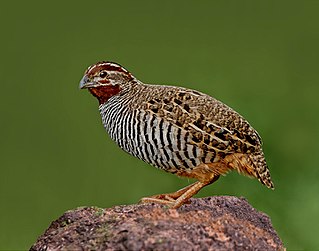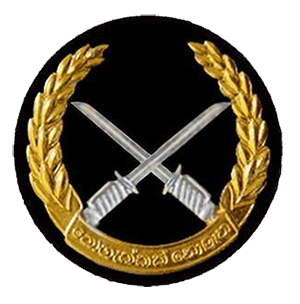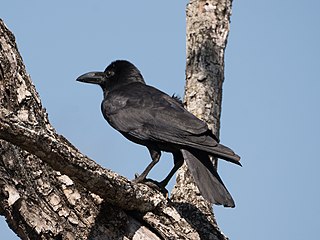
The large-billed crow, formerly referred to widely as the jungle crow, is a widespread Asian species of crow. It is very adaptable and is able to survive on a wide range of food sources, making it capable of colonizing new areas, due to which it is often considered a nuisance, especially on islands. It has a large bill, which is the source of its scientific name macrorhynchos and it is sometimes known by the common name thick-billed crow. It can also be mistaken for a common raven. Johann Georg Wagler first described the species from a holotype obtained from Java in the year 1827. The eastern jungle crow and Indian jungle crow were once considered conspecific and together called the jungle crow.

The Sri Lankan Civil War was a civil war fought in Sri Lanka from 1983 to 2009. Beginning on 23 July 1983, it was an intermittent insurgency against the government by the Velupillai Prabhakaran-led Liberation Tigers of Tamil Eelam. The LTTE fought to create an independent Tamil state called Tamil Eelam in the north-east of the island, due to the continuous discrimination and violent persecution against Sri Lankan Tamils by the Sinhalese-dominated Sri Lanka government.

The Sri Lankan junglefowl, also known as the Ceylon junglefowl or Lafayette's junglefowl, is a member of the Galliformes bird order which is endemic to Sri Lanka, where it is the national bird. It is closely related to the red junglefowl, the wild junglefowl from which the chicken was domesticated. However, a whole-genome molecular study rather show that Sri Lankan junglefowl and grey junglefowl are genetically closer species than the red junglefowl. Sri Lankan junglefowl and red junglefowl diverged about 2.8 million years ago, whereas time of divergence between the Sri Lankan junglefowl and grey junglefowl was 1.8 million years ago.

The yellow-billed babbler is a member of the family Leiothrichidae endemic to southern India and Sri Lanka. The yellow-billed babbler is a common resident breeding bird in Sri Lanka and southern India. Its habitat is scrub, cultivation and garden land. This species, like most babblers, is not migratory, and has short rounded wings and a weak flight and is usually seen calling and foraging in groups. It is often mistaken for the jungle babbler, whose range overlaps in parts of southern India, although it has a distinctive call and tends to be found in more vegetated habitats. Its name is also confused with Turdoides leucocephala, which is also known as white-headed babbler.

The Special Task Force (STF) (Sinhala: විශේෂ කාර්ය බලකාය Visesha Karya Balakaya; Tamil: சிறப்பு அதிரடிப் படை) is an elite police tactical unit of the Sri Lanka Police specialising in clandestine and covert operations, combat and patrolling in urban areas, combat search and rescue, counterinsurgency and counterterrorism operations, crowd control, executive protection, forward observer, hostage rescue, indirect fire, irregular warfare, jungle and mountain warfare, parachuting, psychological warfare, search and rescue people who are in distress or imminent danger from disaster. serving high-risk arrest and search warrants, special reconnaissance, support military operations, tactical emergency medical, tracking, and unconventional tactics. It was formed in 1983 not as a military force, but rather as a highly specialised armed police unit.

Islam is the third largest religion in Sri Lanka, with about 9.7 percent of the total population following the religion. About 1.9 million Sri Lankans adhere to Islam as per the Sri Lanka census of 2012. The majority of Muslims in Sri Lanka are concentrated in the Eastern Province of the island. Other areas containing significant Muslim minorities include the Western, Northwestern, North Central, Central and Sabaragamuwa provinces. Muslims form a large segment of the urban population of Sri Lanka and are mostly concentrated in major cities and large towns in Sri Lanka, for example Colombo. Most Sri Lankan Muslims primarily speak Tamil language, though it is not uncommon for Sri Lankan Muslims to be fluent in Sinhalese. The Sri Lankan Malays speak the Sri Lanka Malay language in addition to Sinhalese and Tamil.

The jungle bush quail is a species of quail in the family Phasianidae. It is native to the Indian subcontinent, where it is found in peninsular India and Sri Lanka. It has also been reported from Nepal but has not been seen there since the 19th century, and an introduced population exists on the island of Réunion. A small species of quail 15–18 cm (5.9–7.1 in) long and weighing 57–82 g (2.0–2.9 oz), it shows significant sexual dimorphism. Males have brown upperparts with blackish and buff marking and whitish underparts with black barring. The face is mainly dark reddish-brown, with brown ear-coverts, a buffy-white moustachial stripe, and the supercilium turning whitish towards the back of the neck. Females have a similar pattern, but with pinkish-brown underparts, more uniform wings, and duller moustachial stripes.
The Eastern University massacre was the arrest and subsequent mass murder of 158 minority Sri Lankan Tamil refugees who had taken refuge in the Eastern University campus close to the city Batticaloa on September 5, 1990. A witness identified Sri Lankan Army personnel as the perpetrators. The event is part of what is known amongst Sri Lankan Tamils as Black September, a series of civilian massacres. The Sri Lankan government eventually established a presidential commission of inquiry. The inquiry found evidence of illegal abductions and mass murder. It also named the responsible parties, but there is currently no evidence of any judicial follow up to the inquiry.
Operation Pawan was the code name assigned to the operation by the Indian Peace Keeping Force (IPKF) to take control of Jaffna from the Liberation Tigers of Tamil Eelam (LTTE), better known as the Tamil Tigers, in late 1987 to enforce the disarmament of the LTTE as a part of the Indo-Sri Lanka Accord. In brutal fighting lasting about three weeks, the IPKF took control of the Jaffna Peninsula from the LTTE, something that the Sri Lankan Army had tried but failed to do. Supported by Indian Army tanks, helicopter gunships and heavy artillery, the IPKF routed the LTTE at the cost of 214 soldiers and officers. Many Indian soldiers died

The Commando Regiment is the commando formation of the Sri Lanka Army. The unit specializes in various roles including hostage rescue, counter-terrorism, unconventional warfare, special reconnaissance, counter-insurgency, and personnel recovery. It was formed in 1980 and is based in Ganemulla, a suburb of Colombo.
The Special Forces Regiment (SF) (Sinhala: විශේෂ බලකාය Visēsha Balakāya;) is a special forces unit of the Sri Lanka Army. Founded in 1986 as a combat tracker team, it was established as a regiment in 1988, and later expanded into a brigade. The unit specialises in a number of roles including counter-terrorism, direct action and covert reconnaissance. Much like the British Army Special Air Service, much of the information about the SF is highly classified due to the secrecy and sensitivity of its operations.

The Eastern Theater of Eelam War IV, the warfare started in the Eastern province of Sri Lanka on July 21, 2006, when the LTTE cut off the water supply to the rice fields in the Mavil aru area in the eastern Trincomalee district. The government military claimed the total control of the Eastern province after capturing the Thoppigala on July 11, 2007, after nearly a year of fighting.

Layard's palm squirrel or flame-striped jungle squirrel is a species of rodent in the family Sciuridae endemic to Sri Lanka. The validity of the subspecies F. l. dravidianus based on a single specimen from the southern tip of India has been questioned, and is probably a juvenile F. sublineatus. Known as මූකලන් ලේනා in Sinhala.
The Battle of Thoppigala was a battle between the Sri Lanka Army and the Liberation Tigers of Tamil Eelam (LTTE) fought during a period of the first half of 2007 over control of the LTTE-dominated peak of Thoppigala, located 40 km northwest of Batticaloa, in eastern Sri Lanka.
The Battle of Vavunathivu took place during the Sri Lankan Civil War. It occurred on 7 March 1997 in which the LTTE militants attacked and overran the Sri Lanka Army military camp at Vavunathivu off Batticaloa.

The Indian jungle crow is a species of crow found across the Indian Subcontinent south of the Himalayas. It is very common and readily distinguished from the house crow, which has a grey neck. In the past the species was treated as a subspecies of another crow species, but vocalizations and evidence from ectoparasite co-evolution and phylogenetic evidence have led to it being considered as a distinct species in modern taxonomic treatments. It differs in its voice from the large-billed crow found in the higher elevations of the Himalayas and the eastern jungle crow overlaps in the eastern part of its range. In appearance, it can be difficult to distinguish from either of these species although the plumage tends to be more uniformly glossed in purple and has a longer bill with a fine tip and a less arched culmen. The Himalayan species has a slightly wedge-shaped tail, unlike the rounded tail of the Indian jungle crow and tends to glide a lot.
A mass murder of Sri Lankan Police officers took place on 11 June 1990. Members of the Liberation Tigers of Tamil Eelam (LTTE), a militant organization, are alleged to have killed over 600 unarmed Sri Lanka Police officers in Eastern Province, Sri Lanka. Some accounts have estimated the number killed as high as 774.
Mahinda I, known colloquially as Midel, was King of Anuradhapura in the 8th century, whose reign lasted from 738 to 741. He succeeded his brother Kassapa III as King of Anuradhapura and was succeeded by his nephew Aggabodhi VI.
Madhu Road National Park is a national park in northern Sri Lanka, approximately 25 km (16 mi) east of Mannar.











